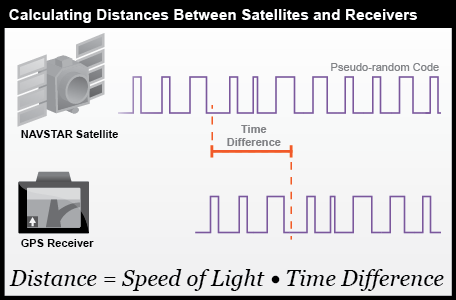
 David Mitlyng for Xairos
David Mitlyng for Xairos
How to Transfer Time
Imagine you want to synchronize your clock to a master clock.
As we mentioned previously, synchronizing clocks that are close to each other is easy.
The real challenge is synchronization over long distances. For this, you need time transfer.
GPS is currently the main source of time synchronization over global distances.
Each GPS satellite knows its position and time, and broadcasts it to the user.
This signal is also used to calculate the distance to the satellite (see below).
You will need this information from multiple satellites to triangulate your position and time.
But if you only care about time, then one GPS satellite will work.
Instead of calculating distance, you can calculate the time of flight from the satellite, and add it to the satellite time.
Other time transfer methods work in a similar fashion: a reference clock sends a stable RF, ethernet, or optical signal, which the receiver uses to calculate the travel time.
The accuracy of the time transfer is impacted by the signal quality, among other things, which tend to degrade over long distances.
Last Week's Theme: Commercial Space Steps Up
- Working with an excellent team of summer interns:
- Andrés Cuéllar-Vega is a quantum researcher of Mexican origin. Recent graduate with a Master of Science in Physics from the University of Texas Rio Grande Valley. Interests include quantum science and technology, numerical modelling, jazz performance, cycling, and philosophy, and is obsessed with Brazilian music and the human perception of time.
- Destiny Mares is an aspiring engineer who wholeheartedly believes that we can live in a world that we design. It was a passion for innovation that brought Destiny to Colorado Mesa University working on a Bachelor of Science in Mechanical Engineering Technology with a minor in Business Administration.
- Kamal Eissa is a Junior at New English School that is passionate about Space Science & Policy, Physics, Astronomy, and Astrophotography. Also enthusiastic about Physics because it’s a discipline where a simple set of equations and principles can help explain the universe and uncover the secrets about our origins, and founded an Astrophotography club.
- Noah Leopold is an undergraduate student at Pitzer college pursuing a degree in physics with additional focus on business and design. Noah is also an entrepreneur, in his first year of college he started a successful late night food service. He hopes to learn about both the quantum technology industry and what it is like to work at a startup so he can apply these lessons to future entrepreneurial ventures.
- Working to expand the team and add Quantum and Timing experts to our Board of Advisors.
- Progress on the proof-of-concept (POC) hardware development continues. Goal is to meet key development milestones within this month.
- Developing new government projects and commercial partnerships.
- Before you can have people landing on the moon, you need a lunar GPS. China, Europe, and the US all recently announced separate plans for lunar position, navigation and timing (PNT) satellites for the moon.
- Last week we mentioned the suspected Russian jamming of GPS in Norway, but a recent article (in Norwegian translated here) suggests the jamming is coordinated with cyber attacks.
- Sometimes the problems with GPS are with shoddy ground terminals. Researchers found a security flaw in a GPS vehicle tracker built by a Chinese firm that “can be easily exploited to track and remotely cut the engines of at least a million vehicles around the world.”
- Another solar storm hit the Earth on Thursday. So far the impacts have been minimal, but the disturbance could make “GPS reception a bit dicey, especially near dawn and dusk.”
- A recent report claims that the “U.S. remains the leading country in quantum computing development, but China is aiming to catch up, with $10 billion of investment claimed in the period to 2030.”
- The US budget for quantum information science (QIS) research was roughly $900M in fiscal 2022, almost double the amount spent in 2019, with much of this funding from the 2018 National Quantum Initiative Act.
- Despite the market downturn, venture investment is still holding up. According to PitchBook, US VC funds closed over $120B through the first half of 2022 propelled by “sustained momentum from the end of 2021,” and TechCrunch claims that “US venture capitalists have never had so much spare cash.” Meanwhile, investment in space startups dropped from $6.1B in Q2 2022 compared to $46.3B for all of 2021.
- Quantum communications technology can be used to securely deliver encryption keys, with another potential application: quantum-secure ATMs.
- Small Satellite Conference, August 6 - 11, Logan, Utah
- Optics + Photonics, August 21 - 25, San Diego, CA
- ION GNSS+ 2022, September 19 - 23, Denver, CO
- IEEE Quantum Week 2022, September 18 - 23, Broomfield, CO
- APSCC 2022, October 18 - 20, Seoul, Korea
- Tough Tech Summit, October 27 - 28, Boston, MA
- International Timing and Sync Forum, November 7 - 10, Dusseldorf, Germany
How to Transfer Time Part II
So how does time transfer from GPS work?
The GPS signal contains a pseudorandom code (sequence of ones and zeros) that is sent to the receiver.
The receiver knows this code, and creates its own version.
By comparing the offset from the satellite and the receiver code, you know the difference in time. This can be used to calculate distance using the speed of light, or the receiver time. 
Credit: Department of Geography, The Pennsylvania State University
Other time transfer methods work in a similar fashion with added complexity to improve performance.
But the accuracy is fundamentally limited by:
- Time of travel changes through the medium of travel.
- The ability to receive a good quality signal.
- The quality of the transmitter and receiver.
- The accuracy of the reference clock.
In addition, for high accuracy time transfer between moving platforms (say, from a satellite like GPS), Doppler and relativistic effects must also be carefully taken into account.
To learn more, please email us or schedule a meeting here.

